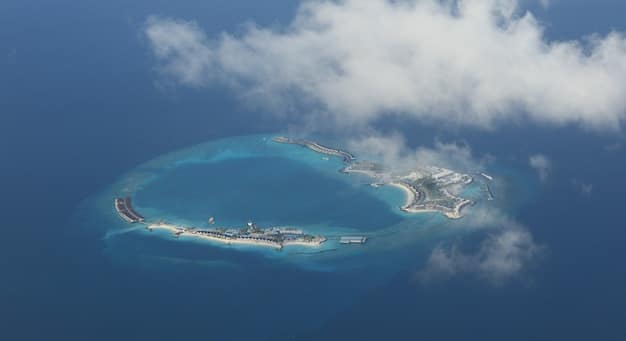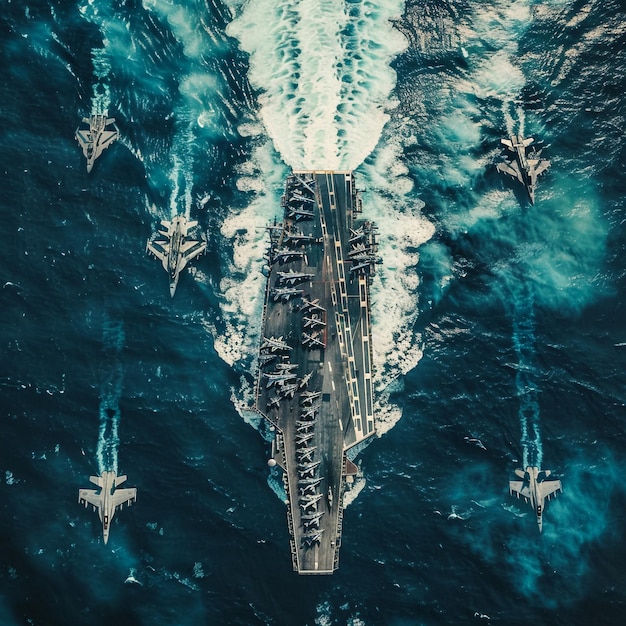US Strategy in the South China Sea: A Deep Dive Analysis

Understanding the US Strategy in the South China Sea involves a multifaceted approach encompassing military presence, diplomatic efforts, and economic initiatives to maintain regional stability and counter China’s increasing influence.
The Understanding the US Strategy in the South China Sea: A Deep Dive is a complex undertaking, involving various geopolitical considerations and strategic objectives. Its crucial to analyze the history of its evolution and the implication it has for all parties.
The Historical Context of US Involvement
The United States has maintained a consistent presence in the South China Sea for decades, driven by concerns over freedom of navigation and regional stability. This involvement has evolved from a primarily economic interest to a complex strategy addressing China’s growing assertiveness.
Understanding the historical context provides valuable insights into the current US approach, highlighting the factors that have shaped its strategic thinking.
Early US Interests and Presence
Initially, the US involvement was largely focused on ensuring unimpeded trade routes.
Escalation of Territorial Disputes
As territorial disputes intensified, so did US military activities in the area, solidifying their dominance.
- Maintaining freedom of navigation became a central tenet of US policy.
- Bilateral and multilateral alliances, particularly with countries like Japan, Australia, and the Philippines, were forged to bolster security.
- Diplomatic efforts to encourage adherence to international law and peaceful resolution of disputes became increasingly important.
In summary, early US strategy was one of dominance, until other players came to the fore in the 21st century, contesting the historical US dominance.
Military Posture and Freedom of Navigation Operations

A cornerstone of the Understanding the US Strategy in the South China Sea is the projection of military power through naval deployments and Freedom of Navigation Operations (FONOPs). These actions serve to challenge excessive maritime claims and demonstrate a commitment to international law.
The US military presence aims to deter unilateral actions by China and reassure allies in the region.
US Naval Presence and FONOPs
US naval deployments are a regular occurrence, projecting US presence in this region.
Deterrence and Assurance
The US seeks to deter hostile or unfriendly actions by China, whilst reassuring allies of US support.
- FONOPs challenge excessive maritime claims, such as those related to artificial islands.
- Joint military exercises with allies strengthen interoperability and demonstrate a united front.
- Advanced military technology, including aircraft carriers and advanced missile systems, are strategically deployed to maintain a credible deterrent.
The military presence by the US is therefore intended both as a show of military force, and also an open declaration of the freedom of navigation rights.
Diplomatic Efforts and Alliances
Complementing its military strategy, the US actively pursues diplomatic engagement to build coalitions and reinforce international norms in the South China Sea. This involves strengthening alliances with regional partners and advocating for peaceful dispute resolution through international forums.
Diplomatic efforts aim to create a united front against coercive actions and promote a rules-based order.
Strengthening Alliances
The US bolsters support from allies in an attempt to discourage hostile actions from China.
Supporting International Law
The US constantly signals support for global legal principles of freedom of navigation and rights for all parties concerned.
- Bilateral treaties with countries like Japan, South Korea, and Australia provide a framework for mutual defense and security cooperation.
- Multilateral forums, such as ASEAN Regional Forum (ARF), are used to address regional security issues and promote dialogue.
- Public statements and diplomatic démarches are employed to condemn actions that threaten stability and violate international law.
The diplomatic effort and alliances support the US’s position as acting in accordance with international law and guidelines, giving them justification for the military and strategic actions in the region.
Economic and Trade Considerations

The South China Sea is vital for international trade, with trillions of dollars worth of goods passing through its waters annually. Understanding the US Strategy in the South China Sea involves ensuring the free flow of commerce and countering any attempts to disrupt trade routes.
The US aims to maintain economic stability in the region and protect its economic interests.
Importance of Trade Routes
Trade routes are vital for the region’s economies and are constantly guarded by the US Navy.
Countering Economic Coercion
The US is conscious not to allow any party to enforce its own economic will upon any other by means of force, or intimidation.
- Trade agreements and initiatives, such as the Indo-Pacific Economic Framework (IPEF), aim to promote economic cooperation and reduce dependence on any single country.
- Investment in infrastructure projects in Southeast Asia provides alternatives to Chinese-led initiatives like the Belt and Road Initiative (BRI).
- Economic sanctions and trade restrictions are considered as tools to deter aggressive behavior and ensure compliance with international norms.
The economic considerations are a major factor in this region and any changes to the status quo will immediately impact on economies around the globe.
Information Warfare and Public Diplomacy
In addition to military, diplomatic, and economic tools, the US employs information warfare and public diplomacy to shape perceptions and counter disinformation in the South China Sea. This involves highlighting the importance of freedom of information and exposing activities that undermine regional stability.
The US seeks to promote transparency and accountability in the region.
Countering Disinformation
Correct information is vital for a successful resolution.
Promoting Transparency
Transparency is promoted in all US media releases, and public diplomacy.
- Strategic communication campaigns are used to promote US policy objectives and counter false narratives.
- Support for independent media and investigative journalism helps expose illegal activities, such as illegal fishing and island building.
- Engagement with civil society organizations and think tanks helps foster a better understanding of the issues and promote informed public debate.
The information sphere and information warfare is now an important aspect to Understanding the US Strategy in the South China Sea.
Challenges and Future Outlook
Despite its multifaceted approach, the US faces significant challenges in implementing its strategy in the South China Sea. These include China’s growing military capabilities, conflicting territorial claim within the region , and the need to balance competing interests among its allies.
The future of the South China Sea hinges on the ability of the US and other stakeholders to manage these challenges effectively.
China’s Growing Influence
China’s influence in the region grows, challenging the US dominance. It therefore remains to be seen if China’s influence continues to grow.
Conflicting Claims
The challenges of conflicting claims by various parties only adds further complexity to the region.
- The US needs to adapt its strategy to address China’s growing military power and assertive foreign policy.
- Efforts to mediate disputes and promote peaceful resolution are essential to preventing escalation.
- Strengthening cooperation with allies and partners will be critical to maintaining a united front against coercion and ensuring regional stability.
As long as the US and China continue to act appropriately and reasonably, there is little risk of any significant events taking place in the region.
| Key Point | Brief Description |
|---|---|
| ⚓ Freedom of Navigation | Ensuring unimpeded passage for international shipping. |
| 🤝 Diplomatic Alliances | Strengthening ties with regional partners to counter coercion. |
| 🛡️ Military Presence | Maintaining a credible deterrent to prevent unilateral actions. |
| 🌐 Economic Stability | Protecting trade routes and countering economic coercion. |
Frequently Asked Questions
▼
The primary goal is to maintain regional stability, ensure freedom of navigation, and uphold international law in the face of competing territorial claims and increasing Chinese influence.
▼
The US Navy conducts regular patrols and Freedom of Navigation Operations (FONOPs) to challenge excessive maritime claims, demonstrate US presence, and deter unilateral actions that could destabilize the region.
▼
Alliances are crucial. The US strengthens ties with regional partners like Japan, Australia, and the Philippines to create a united front against coercion and promote a rules-based order in the South China Sea.
▼
The US promotes economic cooperation through initiatives like the Indo-Pacific Economic Framework (IPEF) and invests in infrastructure projects to provide alternatives to Chinese-led initiatives, aiming to maintain economic stability.
▼
The US employs strategic communication campaigns and supports independent media to counter false narratives, promote transparency, and foster a better understanding of the issues affecting regional stability.
Conclusion
In conclusion, Understanding the US Strategy in the South China Sea involves a comprehensive approach that integrates military, diplomatic, economic, and informational tools. By maintaining a strong presence, fostering alliances, and promoting international norms, the US seeks to ensure stability and freedom of navigation in this vital region, while navigating the challenges posed by China’s growing influence and competing territorial claims. The ongoing developments in the region warrant close attention as they significantly impact global geopolitics.





